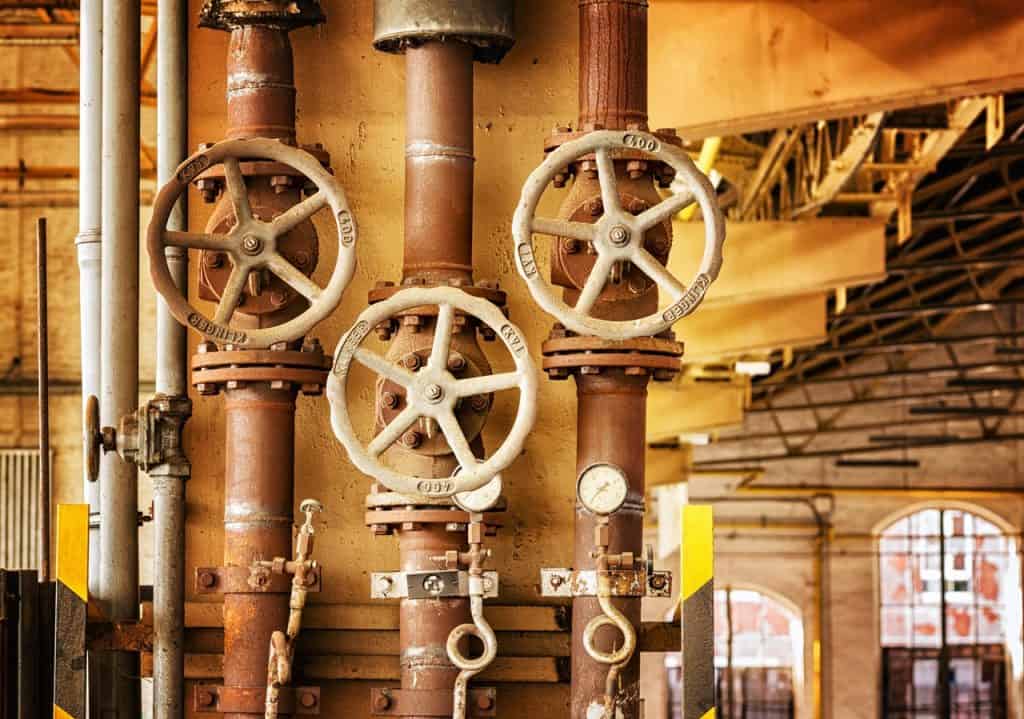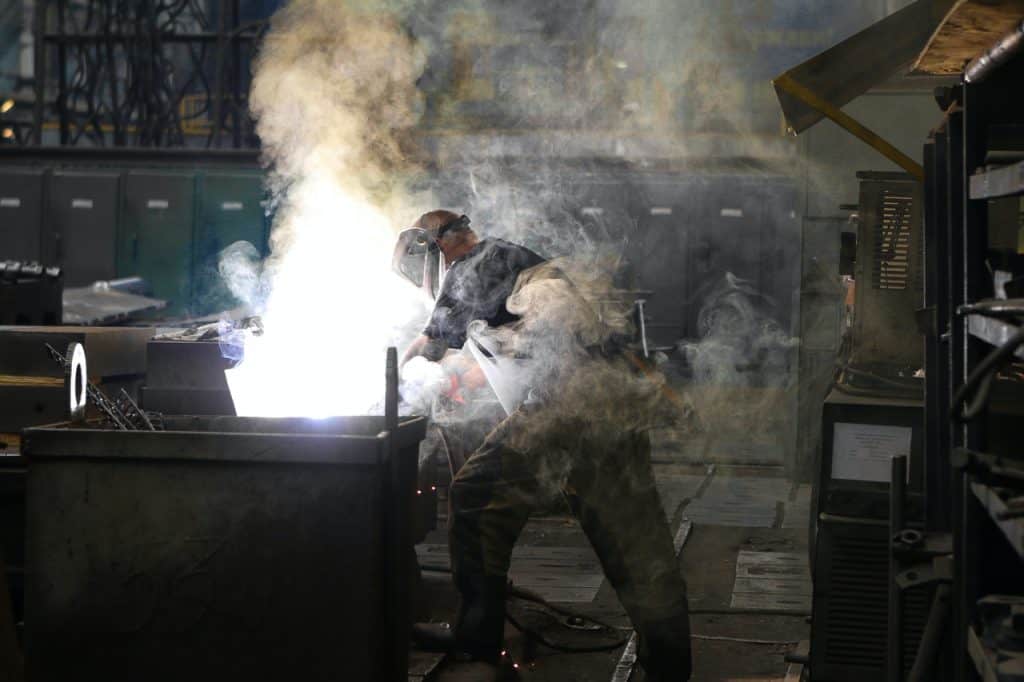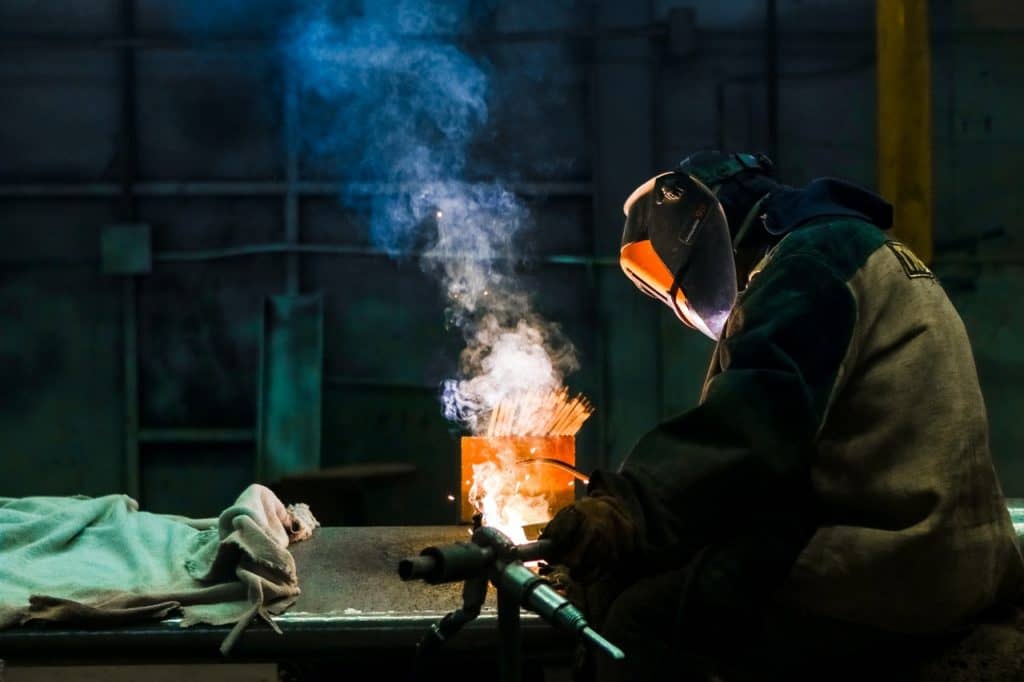Steel, iron, and metal are often used as synonyms. Steel is an iron-carbon alloy, although the word "metal" may refer to any material that carries electricity or heat.
Steel has several various sorts of atoms, whereas iron is a pure element consisting of just one type of atom. This article will explain what each of these phrases means in the context of a customer.
Steel is an iron-carbon alloy. As a rule, it is produced by burning iron ore with coke in a blast furnace to temperatures of roughly 1,500 °F (815 °C).
In order to transform iron into steel, impurities including silicon, sulphur, phosphorus, and manganese are removed at high temperatures.
Depending on its chemical make-up, steel may be utilised to create everything from weaponry to houses.
The strength requirements of varied applications necessitate the production of steel in a variety of grades. Mild steel, high-carbon steel, and stainless steel are the most often used varieties.
When comparing metal, steel, and iron, the quality of the steel makes the most difference. Stainless steel, alloyed steel, and pure steel are the three categories.
All of them are useful in their own unique ways due to their unique qualities.
Pure steel, for instance, isn't extremely durable or corrosion-resistant, therefore it's best suited for uses where strength isn't an issue, such as in pipe or wire coverings.
For usage in applications that need increased hardness or toughness, such as structural beams and automobile components, alloyed steels are created by combining several metals to provide the desired properties.
In addition, the chromium in stainless steels makes them resistant to corrosion, making them a common material for kitchen appliances that spend a lot of time submerged in water, such as pots and pans and sinks.
Table of Contents
What Are The Different Types Of Steel?
You may already know that iron and carbon are combined to form steel, but you may be surprised to learn that there are really more than 3,500 distinct grades of steel.
Carbon content, other alloys present, and processing methods all play a role in establishing a steel's grade.
The Four Types Of Steel
Carbon steel, alloy steel, stainless steel, and tool steel are the four main categories used for classifying steel by grade.
- Carbon steels are almost entirely composed of carbon and iron, with barely traces of other components. Approximately 90% of all steel is made up of this category, making it the most prevalent. Low Carbon Steels/Mild
- Steel (up to 0.3 percent carbon), Medium Carbon Steels (0.3 to 0.6 percent carbon), and High Carbon Steels (more than 0.6 percent carbon) are the three categories of Carbon Steel based on the quantity of carbon in the metal (more than 0.6 percent carbon).
- Nickel, copper, chromium, and aluminium are just a few of the alloying elements found in alloy steels. The metal's strength, ductility, corrosion resistance, and machinability may be modified by adding the appropriate components.
- The exceptional corrosion resistance of stainless steels is due in large part to the 10-20% chromium content of these alloys. These steels have widespread use in things like medical apparatus, pipes, cutters, and machinery used in the food industry.
- Tungsten, molybdenum, cobalt, and vanadium are all included in Tool Steels, which gives them increased resistance to heat and durability, making them ideal for use in cutting and drilling tools.
What Are The Different Grades Of Steel?
Steel grading systems are used to classify steel according to the many variables that affect its physical and functional characteristics.
For instance, the duration spent at certain critical temperatures and the pace at which the steel is cooled may both affect the way in which its molecules bond.
Therefore, its steels with the same alloy composition might have various grades depending on the heat treatment technique.
- Each metal is given a letter designation ("A" is the designation for iron and steel materials) and a sequential number depending on its unique qualities according to the ASTM Grading System.
- The SAE Grading System is based on a numeric value with four digits. Steel type and alloying element concentration are indicated by the first two numbers, and carbon concentration by the final two.
Scientists, engineers, architects, and government organisations all rely on steel grading standards to guarantee the reliability and durability of their products.
These norms serve as a standardised vocabulary for describing steel's qualities and directing producers towards appropriate processing and application methods.
What Is Carbon Steel?
Ninety percent of all steel is made out of carbon steel, which does include some alloying components in it.
Carbon content allows for a further subdivision of carbon steels into three subgroups.
Carbon steel is the most common kind of steel used worldwide. It is made up of iron, carbon, and a number of additional alloying elements in various proportions.
About 90% of all steel is made from carbon, which is the major alloying ingredient in carbon steel.
By doing so, a metal may be made that is both more durable and stiffer.
This occurs because carbon can move across the iron's crystal lattice, filling up the spaces between the metal atoms as it does so because of the atoms present in carbon.
Because of this quality, goods made from carbon steel are very tough.
There are three primary types of carbon steel, and they are low carbon steel (sometimes called mild steel), medium carbon steel, and high carbon steel.
Mild steel, often known as low carbon steel, has a carbon content of 0.04 percent or less.
Carbon steel is one of the major categories here. Forms as varied as the Flat Sheet and the Structural Beam are included. To achieve the required qualities, several ingredients are added or increased.
For Drawing Quality (DQ) steel, for instance, the carbon level is maintained low, and aluminium is added; for Structural Steel, the carbon level is raised, and the manganese content is raised.
Cold-rolling may increase the tensile strength of low carbon steel, which is otherwise distinguished by its considerable malleability and ductility.
To do this, the steel is rolled between two polished rollers under high pressure. The fabrication of metal sheets, boxes, pipes, chains, cables, cases, rivets, vehicle frames, etc. is only some of its most prevalent applications.
Carbon content in medium carbon steel typically falls between 0.31% and 0.60%, with manganese concentration falling between 0.06% and 1.65%. This material is more challenging to shape, weld, and cut than low carbon steel, but it has greater tensile strength.
The heat treatment processes of hardening and tempering are often used on medium carbon steels. This kind is the most popular of the three since it is the most versatile in terms of form and size. You'll find it being utilised for anything from tall buildings and fences to bridges and houses.
The carbon content of high carbon steel, often known as "carbon tool steel," is normally between 0.61 and 1.50 percent. The cutting, bending, and welding of high carbon steel is very challenging.
After being subjected to high temperatures, it hardens and becomes brittle. It is heat treated so that it can withstand wear better. In addition to high-strength wires and springs, it is also helpful in making shock-proof devices.
Manganese Steel
Manganese steel, which contains between 11 and 14 percent manganese, is a work hardening steel.
Manganese steel is utilised to create intricate railway rails because of its superior hardening qualities and wear resistance. Shovel buckets, shot blast cabinets, scrapers, anti-drill security plates, etc. are some further examples of modern uses.
What Is Alloy Steel?
Nickel, copper, chromium, and aluminium are just a few of the alloying elements found in alloy steels. The metal's strength, ductility, corrosion resistance, and machinability may be modified by adding the appropriate components.

While the amount of carbon in steel controls how much it can be hardened, adding specific alloying elements to the steel may make heat treatment less traumatic, which is especially helpful for minimising quenching distortion in complicated thin-walled items.
Alloy steels may be roughly categorised into two groups based on their hardenability: carburising steel, which hardens mostly at the surface, and through-hardening steel, which can extend hardening deep into the metal's core.
The AISI numbering system assigns the prefix "13xx" to steels containing manganese, "2xxx" to steels including nickel, "3xxx" to steels containing nickel-chromium, "4xxx" to steels containing molybdenum, and so on up to "9xxx" for silicon-manganese steels.
Oil quenching is a common method of hardening alloy steels since it is slower than water quenching, which is necessary for simple carbon steels. This may lessen the amount of deformation and allow the hardening to go farther into the material's centre.
To alter its qualities like hardenability, corrosion resistance, strength, formability, weldability, or ductility, alloy steels include alloying elements (such as manganese, silicon, nickel, titanium, copper, chromium, and aluminium) in variable quantities.
Pipelines, vehicle components, transformers, power generators, and electric motors are just some of the many places you'll find alloys steel in use.
Low-alloy steel, also known as High-Strength Low-Alloy steel, is utilised in situations where weight is a consideration, such as with mobile equipment, since it is stronger than plain carbon steels while still being relatively lightweight.
Easy to cold-form and weld. Its corrosion resistance is higher than that of ordinary steel, and it is also resistant to impact, fatigue, and abrasion.
In addition to HY 80 and HY 90, there are a few more low-alloy steels that find employment in the construction of ship hulls and off-road machinery.
For more specialised applications, such as low-temperature toughness or the creation of protective, weathering coatings on ornamental steel used for building facades, alternative low alloy steels are available.
Molybdenum Steel
Molybdenum is an important component of steel alloys because it increases the material's toughness, weldability, and corrosion resistance.
For this reason, structural steels made from this material are often employed in saltwater settings. Molybdenum steel is also used in oil and gas pipelines and ball bearings.
Nickel Steel
Alloys of nickel and steel are among the most widely used types of steel in the world. Along with its high nickel concentration (around 3.5 percent), it also contains about 0.35 percent carbon.
Adding nickel makes structural steel stronger without reducing its flexibility, which is its unique selling point. Increased toughness makes the material less likely to crack under stress.
Hardening is not a problem with nickel-chromium steel. The chromium in this steel makes it resistant to corrosion and gives it excellent oxidation and wear resistance.
Also, with a certain amount of carbon, it's considerably tougher and possesses high-temperature strength. Three and a half to three and a half percent nickel and one and a quarter to one and a half percent chromium are the typical nickel-chromium steel percentages.
Nickel is added to steel at the time of quenching to reduce the distortion value.
Since the inclusion of nickel reduces the steel's temperature, this material is perfect for heat treatment and provides exceptional response to temperature changes.
Silicon Steel
Silicon steel is the most important material utilised nowadays because of its high magnetic force. When it comes to applications like huge motors and generators, tonnes of silicon steel are utilised, whereas smaller devices like pulse transformers and relays only use ounces.
It is sought for for a variety of reasons, including the lowering of saturation, increased resistivity, magnetostriction, and magneto-crystalline anisotropy. In addition, steel is the material of choice for making permanent magnets since it only requires a 1-2 percent silicon addition to become magnetic.
What Is Stainless Steel?
Due to their great corrosion resistance, steels often include 10-20% chromium as an alloying element. Use of these steels is widespread in the medical, plumbing, cutting tool, and food processing industries.
High corrosion resistance is one of the key reasons why stainless steels (which typically include between 10 and 20 percent chromium as the principal alloying element) are so highly sought after. More than 11 percent chromium makes steel much more corrosion-resistant than mild steel. Crystal structure allows us to classify these steels into three broad categories:
With a typical composition of 18% chromium, 8% nickel, and less than 0.8% carbon, austenitic steels are non-magnetic and cannot be heat treated. The majority of the stainless steel industry is comprised of austenitic steels, which find widespread use in food processing machinery, cookware, and pipework.
Ferritic steels have low carbon content (less than 0.1 percent), a high chromium content (12-17 percent), and additional alloying elements (such as molybdenum, aluminium, or titanium) in trace quantities. While heat treatment will not help to harden these magnetic steels, cold working will make them stronger.
The chemical composition of martensitic steels includes 11-17% chromium, 0.4% nickel, and 1-2% carbon. Knives, saws, and other cutting instruments, as well as dental and surgical tools, all benefit from these magnetic and heat-treatable steels.
Stainless steel, in contrast to carbon/alloy steel, is a steel alloy that is highly resistant to corrosion. Chromium (typically at least 11 percent), nickel, and molybdenum are typical alloying materials. The alloy percentage of a material is typically between 15 and 30 percent.
Processing and handling of food, medical equipment, hardware, household appliances, and building construction are all common examples of where these materials are put to use.
You may get Stainless Steel from any Metal Supermarket, or you can get it online. Bar stock, channel, beam, angle, and many more forms may be purchased from this supplier. Additionally, it may be shaped in whatever way you choose.
Difference Between Metal And Steel
Many people mistakenly believe that metal and steel are interchangeable because of how often they are used interchangeably. However, despite their superficial similarities, metal and steel are in fact quite distinct materials.

Steel is an alloy created from metal, whereas metal is a naturally occuring element found in the Earth's crust.
Learn about what makes metal and steel special, and how they differ from one another, below.
Metal vs. Steel
Unlike steel, which is a single chemical element, metal is composed of a variety of elements that are similar to those you studied in high school chemistry. Nonetheless, you should be aware that metals may be found in the Earth's crust without any human intervention.
On the other hand, steel is an iron-based alloy, hence it cannot exist in the absence of metal.
Therefore, steel is not a true metal but rather a subset of the metal family.
Which Is Stronger: Metal or Steel?
Steel is substantially more durable than metal, which may be found in the Earth's crust.
Because of its malleability, metal is ideal for use in jewellery, ornamental projects, and even surgical implants. Steel's strength and indestructibility make it an excellent material for use in manufacturing things like skyscrapers, commercial buildings, residences, ships, and firearms.
How Is Steel Produced?
Iron ore must be extracted from the ground and then smelted in huge furnaces called blast furnaces in order to create steel. Iron ore goes through this process to have contaminants like silica, phosphorus, and sulphur removed, and a measured quantity of carbon supplied.
A decrease in carbon content is required for the addition of additional elements before the material can be considered steel. Slabs, blooms, and billets are produced by casting the liquid in contemporary foundries.
Iron Versus Steel – What Is The Difference?
Iron is an element, whereas steel is an alloy of iron and carbon. The word "worked" implies "forged," thus some people may assume that "wrought iron" refers to steel as well.
However, the roots of the phrases predate even industrial-scale ironwork.
Cast material was full of flaws and inclusions since the first purification of iron from ore was a simple procedure compared to what it is now. Wrought iron, which is made by forging cast iron in a thermomechanical process, is a more refined and improved form of iron that may be used as a structural material.
History of Iron Production
Smelting, the process of heating iron-bearing ore to extract the element and melt it, acquired new names for its byproducts when production of iron shifted from artisanal to industrial.
Separated and molten iron was poured into ingot moulds, often known as "sows," to create the first type of "crude iron." The pigs were butchered into smaller parts for future use. The phrase "pig iron" comes from the fact that larger "pigs" were produced by breeding "sows."
To transform "pig iron" into "worked iron," a blacksmith would heat tiny ingots at the forge and hammer them, crushing the voids and distributing the impurities.
While it's possible that some impurities may remain after forging, the process should break up any big clusters of contaminants into smaller sizes that are less likely to impair the metal's structure.
Creation of Steel
Steel, an iron alloy, was developed by adding trace quantities of carbon to molten iron.
Carbon atoms scattered across the iron boost its mechanical characteristics by distorting the iron's crystal structure.

An additional step of thermomechanical processing, such as forging, was and is necessary to guarantee the cast structure of the initial ingot is transformed, ensuring consistent mechanical properties by dispersing clusters of impurities or alloying elements and crushing voids that would weaken the final product.
Forging at high temperatures also causes recrystallization, which leads to a "fine grain" microstructure in the alloy.
Toughness and fatigue resistance are improved in the steel as a result.
Steel Vs. Iron Properties
In terms of yield and ultimate tensile strength, steel outperforms iron, and it is also harder than many varieties of iron (often measured as fracture toughness).
Most commercially available steels have less than 0.5 percent carbon by weight in their additions.
Increasing the percentage of carbon added to steel makes it stronger but also more brittle. Steel also contains manganese, silicon, phosphorus, and sulphur.
Nickel, chromium, molybdenum, and vanadium are just some of the metals that may be added to the steel that falls under the "alloy steel" category. Stainless steel, which includes chromium, is a common low-carbon steel.
The steel alloy benefits from the inclusion of each element, even in trace quantities.
Therefore, an alloy consisting mostly of the iron becomes one of the most useful materials ever developed when the formula for the steel alloy is managed and the material is treated properly.
Conclusion
Iron ore and coke are heated to temperatures of 1,500 °F (815 °C) in a blast furnace to create steel, an iron-carbon alloy. Carbon steel, alloy steel, stainless steel, and tool steel are the four major types utilised to make anything from weapons to homes. The carbon concentration, other alloys present, and processing methods all have a part in determining a steel's grade, which is the primary determinant of the steel's quality. Carbon steels are primarily made of carbon and iron, with just minimal amounts of additional elements. Carbon content defines the three types of Carbon Steel: low- or mild-carbon steels, medium-carbon steels, and high-carbon steels.
Nickel, copper, chromium, and aluminium are all examples of alloy steels that can be improved by modifying their chemical composition to increase their strength, ductility, corrosion resistance, and machinability. Tungsten, molybdenum, cobalt, and vanadium are all found in tool steels, giving them improved durability and resistance to heat. There are many factors that might alter the physical and functional properties of steel, hence grading systems are employed to categorise it. Most steel is carbon steel, which consists of iron, carbon, and a variety of other alloying elements. In carbon steel, carbon is the primary alloying element.
Low carbon steel (also known as mild steel) is one of the most common forms of carbon steel, along with medium carbon steel and high carbon steel. The carbon content of low carbon steel is 0.04 percent or less, while that of medium carbon steel is from 0.31 percent to 0.60 percent, and that of manganese from 0.06 percent to 1.65 percent. High carbon steel has a higher tensile strength than low carbon steel but is more difficult to work with in terms of shaping, welding, and cutting. Medium carbon steels are commonly subjected to hardening and tempering heat treatment techniques. When alloy steel is heat treated, it becomes work hardening steel, which increases its durability.
Electric motors, anti-drill security plates, electric rails, shovel buckets, shot blast cabinets, and scrapers are all made using it. Carburizing steel, which hardens primarily at the surface, and through-hardening steel, which can extend hardening deep into the metal's core, make up the two main categories of hardenable alloy steels. Alloying elements like manganese, silicon, nickel, titanium, copper, chromium, and aluminium are incorporated into alloy steels to modify the material's properties. Due to oil quenching being a slower process of hardening alloy steels, it is widely used. There are other low-alloy steels that can be utilised as an alternative to HY 80 and HY 90 in ship hulls and off-road gear.
Molybdenum steel has excellent toughness, weldability, and corrosion resistance, making it a vital part of steel alloys, whereas nickel-chromium steel is utilised in oil and gas pipelines and ball bearings. Silicon steel, with its strong magnetic force, is the most important material used today, and stainless steel is the metal of choice when fabricating permanent magnets. Stainless steel is a type of steel alloy with exceptionally strong corrosion resistance; chromium is typically between 10 and 20 percent of the alloy. Austenitic steels, ferritic steels, and martensitic steels are the three main types, and they are all employed in various types of food processing equipment, as well as in the kitchen and the construction of pipes and pots and pans. Metal is an element present in the Earth's crust, while steel is an alloy made from metal.
Steel, an iron-based alloy, is chemically inert without the presence of metal, and hence belongs to this class. It is much more long-lasting than metal, making it perfect for usage in things like jewellery, decorations, and even medical implants. Steel is made by mining for iron ore and then smelting the ore in huge furnaces called blast furnaces. Wrought iron is a superior type of iron that may be utilised as a building material; it is created by forging cast iron using a thermomechanical process. When iron production moved from an artisanal to an industrial level, so did the names of the byproducts of smelting.
Steel was created when a very small amount of carbon was added to molten iron, creating an alloy. An second thermomechanical processing step, such forging, is required to maintain uniform mechanical characteristics by dispersing clusters of impurities or alloying elements and crushing voids. Recrystallization, brought on by forging at high temperatures, results in a "fine grain" microstructure in the alloy. Steel is tougher than several types of iron and has a far higher yield and ultimate tensile strength. Metals including manganese, silicon, phosphorus, and sulphur can be found in steel.
Common examples of low-carbon steel include stainless steel, which contains chromium. Steel alloy is one of the most beneficial materials ever created since it makes use of every element present, no matter how little the amount.
Content Summary
- Steel is an iron-carbon alloy.
- The strength requirements of varied applications necessitate the production of steel in a variety of grades.
- When comparing metal, steel, and iron, the quality of the steel makes the most difference.
- You may already know that iron and carbon are combined to form steel, but you may be surprised to learn that there are really more than 3,500 distinct grades of steel.
- Carbon steel, alloy steel, stainless steel, and tool steel are the four main categories used for classifying steel by grade.
- Scientists, engineers, architects, and government organisations all rely on steel grading standards to guarantee the reliability and durability of their products.
- About 90% of all steel is made from carbon, which is the major alloying ingredient in carbon steel.
- There are three primary types of carbon steel, and they are low carbon steel (sometimes called mild steel), medium carbon steel, and high carbon steel.
- Nickel, copper, chromium, and aluminium are just a few of the alloying elements found in alloy steels.
- To alter its qualities like hardenability, corrosion resistance, strength, formability, weldability, or ductility, alloy steels include alloying elements (such as manganese, silicon, nickel, titanium, copper, chromium, and aluminium) in variable quantities.
- In addition to HY 80 and HY 90, there are a few more low-alloy steels that find employment in the construction of ship hulls and off-road machinery.
- For more specialised applications, such as low-temperature toughness or the creation of protective, weathering coatings on ornamental steel used for building facades, alternative low alloy steels are available.
- Stainless steel, in contrast to carbon/alloy steel, is a steel alloy that is highly resistant to corrosion.
- Wrought iron, which is made by forging cast iron in a thermomechanical process, is a more refined and improved form of iron that may be used as a structural material.
- Steel, an iron alloy, was developed by adding trace quantities of carbon to molten iron.
- Toughness and fatigue resistance are improved in the steel as a result.
- Increasing the percentage of carbon added to steel makes it stronger but also more brittle.
- Stainless steel, which includes chromium, is a common low-carbon steel.
- The steel alloy benefits from the inclusion of each element, even in trace quantities.
Frequently Asked Questions
All steel contains iron, but it also contains carbon. ... The primary difference between iron and steel is that the former is a metal, whereas the latter is an alloy. Iron is simply a metal element that occurs naturally on Earth. In comparison, steel is a man-made alloy that's made by mixing iron and carbon together.
Steel is stronger than iron (yield and ultimate tensile strength) and tougher than many types of iron as well (often measured as fracture toughness). The most common types of steel have additions of less than . 5% carbon by weight. ... Other elements commonly found in steel are manganese, silicon, phosphorus, and sulfur.
- Carbon Steel. Carbon steel looks dull, matte-like, and is known to be vulnerable to corrosion. ...
- Alloy Steel. Next up is alloy steel, which is a mixture of several different metals, like nickel, copper, and aluminum. ...
- Tool Steel. ...
- Stainless Steel.

